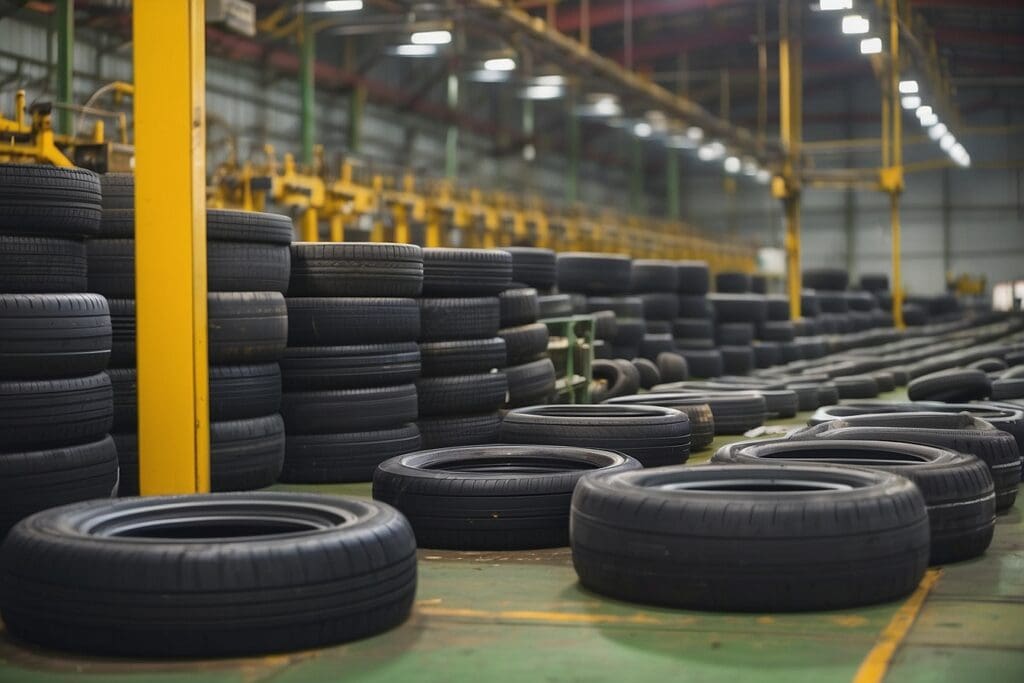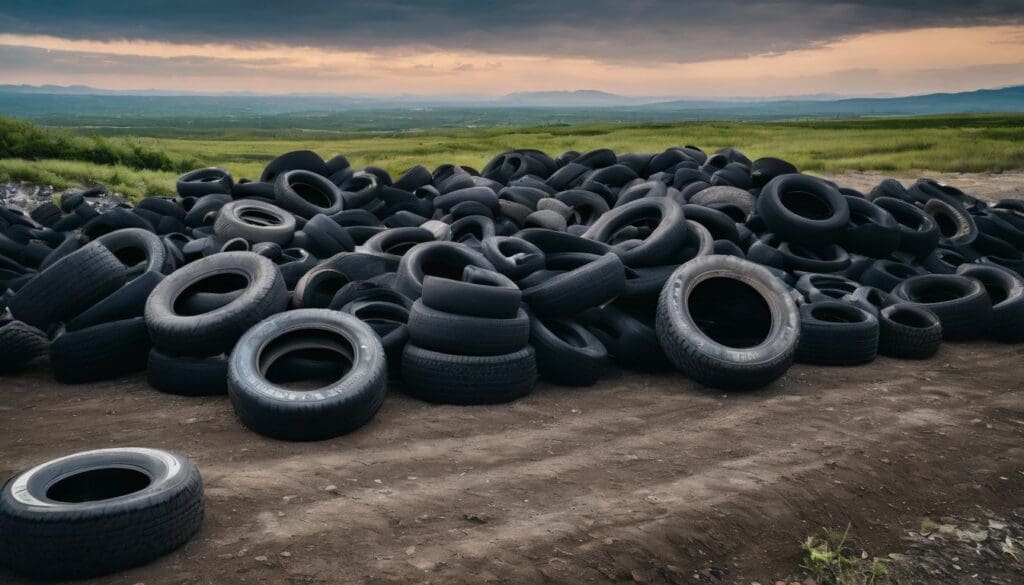We’re all quite fond of the liberty our trusty vehicles afford us, yet it’s seldom that we spare a thought for the humble tyres that whisk us away on every adventure. As enthusiasts who cherish both spirited road trips and tender green initiatives, we acknowledge that overlooking such a critical aspect does have its consequences – notably, tyre manufacturing contributes to around 1,400 million tonnes of CO2 emissions each year.
In our blog, we delve into the often-unseen environmental footprint left by tyre production and share some hands-on tips for adopting more eco-friendly habits. Join us as we journey together towards a future that is kinder to our planet!
Key Takeaways

- Tire production contributes to significant chemical emissions, such as sulphur dioxide and nitrogen oxides, which harm air quality and add to climate change.
- Deforestation in Southeast Asia for rubber tree plantations is driven by demand from the tire industry, leading to biodiversity loss and increased carbon emissions.
- The energy – intense methods used in producing tires deplete natural resources like fossil fuels, highlighting the need for more renewable energy sources within the industry.
- Chemical recycling of tires can turn old materials into new ones, reducing waste and conserving raw materials.
- Collaboration between consumers who demand eco – friendly tires and manufacturers that implement green practices is key in lessening environmental damage.
Environmental Impact of Tyre Production
Tire production has a significant environmental impact, including chemical emissions, deforestation, depletion of natural resources, and high energy consumption. These factors contribute to the overall negative effects that tire production has on the environment.
Chemical emissions
We must face the harsh truth that tyre production releases a significant amount of chemical emissions into our atmosphere. These pollutants include sulphur dioxide, nitrogen oxides, and volatile organic compounds that contribute to smog and acid rain, affecting both human health and the environment.
Factories producing tyres also discharge solvents and toxic chemicals, adding to greenhouse gas emissions that drive climate change.
Manufacturers can no longer ignore their impact on air quality as they consume resources and release harmful substances. As we seek solutions for these problems in the sections ahead, let’s consider how conservation efforts could transform the materials we use and reduce this heavy toll on our planet.
Now turning towards another critical issue—deforestation—we’ll explore its relation to tire production next.
Deforestation
Tire production contributes to deforestation when the rubber trees are cleared to make way for plantations. The demand for natural rubber, a key component in tyre manufacturing, has led to widespread deforestation in Southeast Asia and other regions.
This clearing of forests not only threatens biodiversity but also releases carbon dioxide into the atmosphere, exacerbating climate change. It’s crucial for environmentally conscious individuals and organisations to consider the impact of tyre production on deforestation and seek sustainable alternatives.
Tyre manufacturers should invest in sustainable rubber sourcing practices or consider using alternative materials that do not contribute to deforestation. By prioritising the use of renewable resources, such as bio-based or synthetic rubber made from eco-friendly materials, we can reduce the environmental harm caused by tyre production.
Depletion of natural resources
Tire production contributes to the depletion of natural resources, including rubber and oil. The extraction of these raw materials for tire manufacturing leads to habitat destruction and loss of biodiversity.
This process also puts a strain on ecosystems and disrupts the balance in natural environments. Additionally, the energy-intensive nature of tire production further depletes finite natural resources such as fossil fuels, exacerbating environmental harm.
Furthermore, deforestation for rubber tree plantations is a direct result of tyre production’s demand for rubber. This has far-reaching consequences, not only eroding vital habitats but also impacting climate regulation and worsening global warming by reducing the planet’s carbon absorption capacity.
Energy consumption
With the depletion of natural resources posing a significant environmental concern, it’s essential to address the tyre production industry’s energy consumption. Utilising renewable energy sources and implementing energy-efficient processes can significantly reduce the carbon footprint associated with tyre manufacturing.
By embracing sustainable practices such as using solar or wind power, reducing electricity usage during production, and optimising resource allocation, the tyre industry can contribute to overall environmental conservation efforts.
Additionally, investing in research and development for eco-friendly materials that require less energy to produce can further mitigate the impact on our planet.
Solutions for Reducing Environmental Impact
By using renewable materials, implementing chemical recycling, and promoting proper disposal and recycling of tyres, we can work towards reducing the environmental impact of tyre production.
Read more to learn about how sustainable practices can make a difference.
Use of renewable materials
Manufacturers can reduce the environmental impact of tyre production by using renewable materials such as natural rubber, plant-based oils, and organic fibres. These materials are sustainable and can be replenished, lowering the demand for non-renewable resources.
Incorporating renewable materials into tyre production reduces reliance on fossil fuels and minimises carbon emissions during manufacturing processes. Additionally, it promotes eco-friendly practices within the industry and aligns with efforts to achieve environmental sustainability.
Incorporating renewable materials not only decreases the ecological footprint but also enhances the quality and performance of tyres. By harnessing these sustainable alternatives, manufacturers contribute to a greener future while meeting consumer demand for eco-conscious products.
Chemical recycling
Chemical recycling offers an innovative solution for reducing the environmental impact of tyre production. By breaking down tyres into their chemical components and using them to create new materials, this process minimises the need for raw resources while diverting waste from landfills.
Chemical recycling also plays a vital role in reducing emissions and energy consumption associated with traditional manufacturing processes. This eco-friendly approach aligns with the principles of sustainable manufacturing and waste management, offering environmentally conscious individuals a tangible way to support conservation efforts.
Furthermore, chemical recycling contributes to the circular economy by promoting the reuse of materials that would otherwise end up as pollution or waste. Embracing this method is crucial in addressing plastic pollution from tyres and minimising deforestation linked to rubber production.
Proper disposal and recycling of tyres
Transitioning from chemical recycling, proper disposal and recycling of tyres is crucial in mitigating the environmental impact of tire production. Ensuring that old and worn-out tires are disposed of responsibly can prevent them from becoming sources of pollution.
Recycling tires not only reduces the strain on natural resources but also minimises the energy required to produce new ones. Adopting these practices supports sustainable materials, reducing deforestation and depletion of natural resources.
Manufacturers and consumers should collaborate to ensure that waste tire pollution is minimised through eco-friendly production and responsible disposal methods. Government regulations play a significant role in enforcing proper waste management procedures, fostering a circular economy for tire products.
The Dangerous Effects of Tyre Dust
Tire dust, a byproduct of tire wear and tear, leads to microplastic pollution in the environment, contributing to air pollution and respiratory health risks for humans. Additionally, tire dust can contaminate soil and water sources, posing serious environmental consequences.
Microplastic pollution
Tire dust, created by the wear and tear of tyres on roads, is a significant source of microplastic pollution. Over time, as tyres degrade, they release tiny particles less than five millimetres in size.
These microplastics are then carried by wind and rainwater into our environment, where they can accumulate in soil and water systems. The presence of these microplastics poses a threat to marine life and ecosystems when they enter water bodies.
Additionally, once consumed by aquatic organisms, these microplastics can make their way up the food chain, ultimately ending up on our dinner plates.
Furthermore, as an environmentally conscious individual supporting conservation efforts, it’s important to be aware of this issue and advocate for sustainable solutions that minimise tyre dust production and prevent further contamination of our environment.
Air pollution and respiratory health risks
As we consider the impact of tyre dust on the environment, it’s crucial to recognise that air pollution is a significant concern. When tyres degrade, they release particulate matter and chemicals into the air, contributing to poor air quality.
The fine particles from tyre dust can exacerbate respiratory issues such as asthma and other lung diseases when inhaled. This poses serious health risks for individuals, particularly those living in urban areas with high levels of vehicular traffic.
The presence of microplastics from tyre dust further compounds these risks by releasing harmful pollutants into the atmosphere. These pollutants are known to have adverse effects on respiratory health when inhaled over prolonged periods.
Soil and water contamination
Tire dust, composed of microplastics and other harmful substances, can contaminate soil and water when it accumulates. These particles leach chemicals into the ground, negatively impacting soil quality and potentially harming plant life.
When tyre dust is washed into water bodies through rain or runoff, it pollutes aquatic ecosystems, affecting marine life and overall water quality. The resulting contamination poses serious risks to the environment and public health.
Therefore, sustainable measures must be taken to minimise the release of tyre dust and prevent its detrimental effects on soil and water.
To address this issue effectively, environmentally conscious individuals can support eco-friendly initiatives such as promoting proper tyre disposal methods or choosing products from manufacturers committed to reducing tyre dust emissions.
The Need for Sustainable Tyre Production Practices
Sustainable tyre production is essential for reducing the environmental impact of tire manufacturing. Government regulations, consumer awareness and demand, as well as the implementation of green technologies and collaboration between tire manufacturers and environmental organisations are crucial in achieving this goal.
Government regulations
Government regulations play a crucial role in shaping the environmental impact of tyre production. Regulations regarding chemical emissions, waste disposal, and sustainable sourcing of raw materials are essential for mitigating the negative effects of tyre manufacturing on the environment.
These regulations aim to ensure that tyre manufacturers adopt eco-friendly practices, reduce deforestation, minimise energy consumption, and limit pollution during production and disposal processes.
By enforcing strict guidelines and standards, governments can promote sustainable practices within the tyre industry.
Consumer awareness and demand
Transitioning from government regulations to consumer awareness and demand, it is imperative for environmentally conscious individuals to understand the impact of their purchasing decisions.
Consumer awareness plays a vital role in driving demand for sustainable tyre production practices. By choosing eco-friendly tyre options and supporting manufacturers that prioritise environmental responsibility, consumers can significantly influence the industry’s direction towards more sustainable and eco-conscious practices.
Furthermore, by actively seeking out information about a tyre manufacturer’s environmental initiatives and engaging in discussions about eco-friendly production methods, consumers can push for positive change within the industry.
Implementation of green technologies and processes
To reduce the environmental impact of tyre production, we can implement green technologies and processes. This involves investing in sustainable energy sources, such as solar or wind power, to minimise carbon emissions during manufacturing.
Additionally, utilising eco-friendly materials like natural rubber and soy-based compounds instead of traditional synthetic chemicals can significantly decrease the ecological footprint of tyre production.
Moreover, optimising manufacturing processes to reduce waste and implementing closed-loop systems for recycling materials will contribute to a more sustainable approach in the tyre industry.
Collaboration between tyre manufacturers and environmental organisations.
Implementing green technologies and processes is crucial for sustainable tire manufacturing. A collaboration between tyre manufacturers and environmental organisations can foster innovation in eco-friendly production methods, bringing about positive change.
By working together, companies can prioritise the use of renewable materials, minimise chemical emissions, and implement efficient recycling systems to reduce the environmental impact of tire production.
This partnership also allows for sharing best practices and knowledge to create a more sustainable future for the industry and the planet.
Moreover, establishing close ties with environmental organisations enables tyre manufacturers to stay updated on the latest research and regulations regarding eco-friendly practices.
Conclusion
In conclusion, it is evident that tire production has a significant environmental impact. Chemical emissions, deforestation, and energy consumption are just some of the detrimental effects.
However, by implementing sustainable practices such as using renewable materials and proper disposal methods, we can work towards reducing this impact. It is crucial for both governments and consumers to push for eco-friendly tire production to protect our environment for future generations.
FAQs
1. What are the environmental impacts of tire production?
Tire production can lead to deforestation, contribute to pollution, and increase scrap tire waste, affecting our planet’s health.
2. How do tire fires affect the environment?
Tire fires release toxic smoke into the air, causing serious air quality issues and harming wildlife and ecosystems nearby.
3. Can making tires hurt forests and trees?
Yes, deforestation can happen when we clear land for rubber plantations needed in tire manufacturing, impacting nature’s balance.
4. What happens to old tires that harm the environment?
Old tires often pile up in landfills or get illegally dumped; this leads to environmental consequences like leaching chemicals into soil and waterways.
5. Are there any ecofriendly ways to produce tires?
Ecofriendly tire production involves using sustainable materials and methods to reduce environmental harm while still making quality tires for vehicles.





